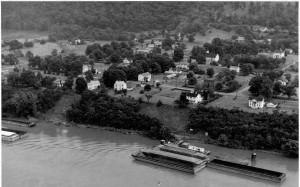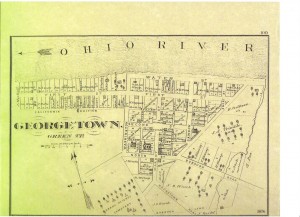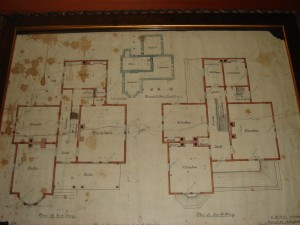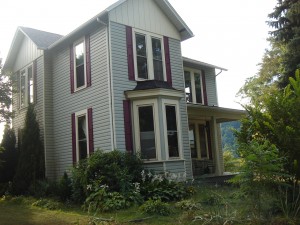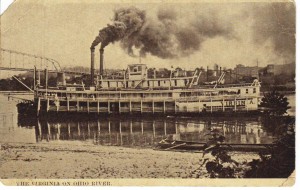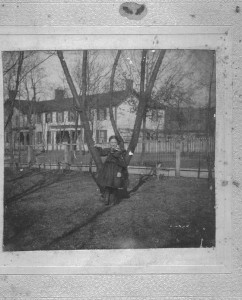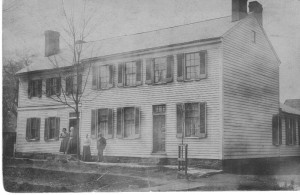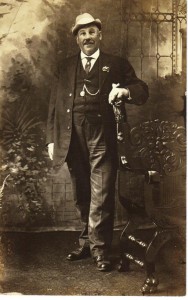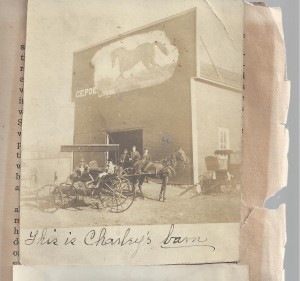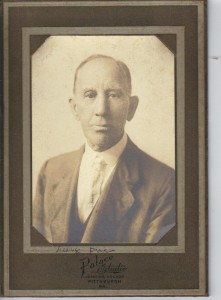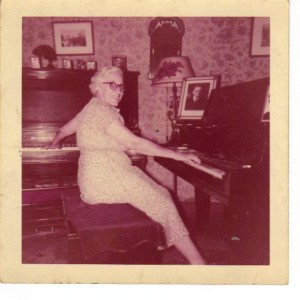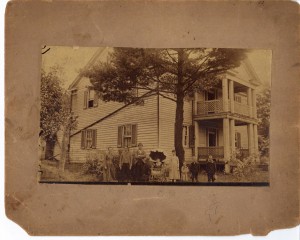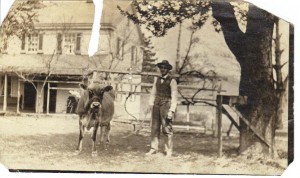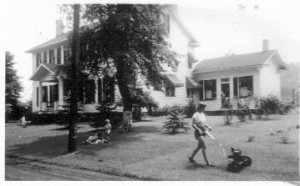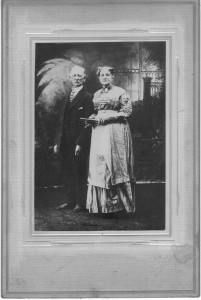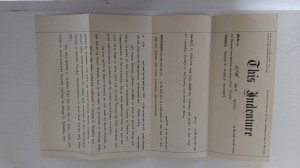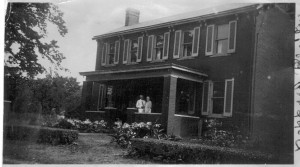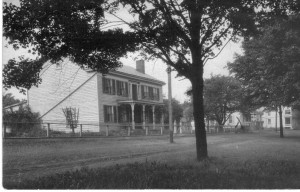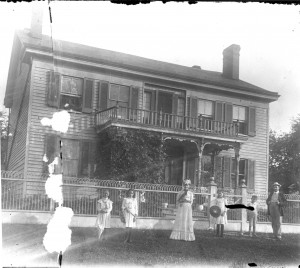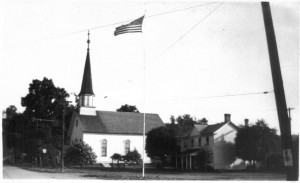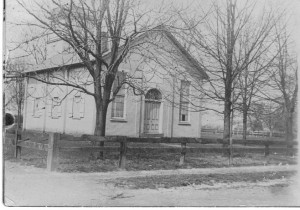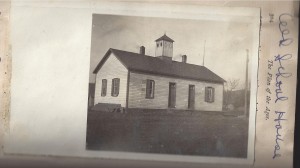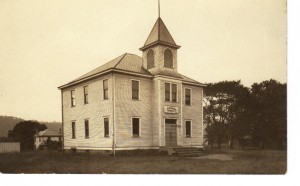History in Homes
Georgetown began well: riverboats, a ferry, a railroad, a trolley, two churches, a school, hotels, taverns, groceries, a tea room, a photography studio, a milliner’s shop. and a post office. It was always a great place for rivermen. But money and history stopped by, stayed for a time, and played through.
Approaching Georgetown from the river on foot today, one climbs a steep grade up the ferry road. The first house on the right was the home of Capt Thomas Stevenson Calhoon whose entire life was spent on the river until he retired in 1904. His father, Capt John Calhoon drowned at Marietta, OH while in command of one of Capt Jacob Poe’s packets. Thomas S Calhoon was 12 years at the time of his father’s death in 1846. At a younger than normal age, Thomas S Calhoon was pilot and clerk on several of Jacob Poe’s steamboats suggesting that Thomas S Calhoon received at least part of his river education from Jacob Poe.
In 1862 Thomas S Calhoon obtained his first pilots license. During the Civil War he served with Georgetown captains and pilots transporting troops and supplies on the western rivers. He was the clerk and part owner of the Horizon when it collided with the Moderator after running the Vicksburg batteries. Many soldiers lives were lost.[1]
In 1866 he was the clerk of the Amelia Poe on its first trip to Ft Benton in the Montana Territory. In 1867 on his second trip to Ft Benton, he was first clerk aboard the Ida Stockdale commanded by Capt Grant Marsh. Thomas S Calhoon wrote home in 1867 that they “were treated to a volley of arrows. One struck the chimney and fell to the deck, and one struck the spar and stuck into it.”[2] The danger of Indian attack in the Dakota and Montana Territories was always real.
As owner and master of the steamer Sallie, Capt Calhoon made three more runs to Ft Benton from 1868-1870. I doubt that any person other than Capt Marsh had more experience on the Missouri River system.
Capt Thomas Calhoon had a long varied steamboat career working as a clerk, pilot, captain, and owner spanning more than fifty years. In addition to serving aboard troop and supply transports during the Civil War and making at least six dangerous runs to the Montana Territory, he worked on every river in the Mississippi River system on famed steamers such as the Amelia Poe, Glencoe, Ida Stockdale, Sallie, Katie Stockdale, and the Virginia (his last command).

Capt Thomas S Calhoon (left) aboard the Virginia 1896 (From the Collection of The Public Library of Cincinnati and Hamilton County)
Also in 1869, Capt Thomas S Calhoon with Jacob Poe and Andrew J Parr as pilots delivered the packet Barranquilla to New Orleans. From there, a Gulf pilot steered her to the Magdalena River in Columbia, South America. The route from Pittsburgh to the Magdalena River was long and dangerous. From New Orleans the packet sailed along the coast to Key West. From there she island hopped via Jamaica to reach her destination; badly battered but operative. Sternwheel packets were not designed for ocean adventures. The distance these men traveled was incredible.
Across Market St from the Calhoon home was the River Hotel which was erected in 1802 overlooking the Ohio River. It was, and is still, an imposing sight from the river. It was operated by Thomas Foster, who received a license to operate in 1805. Located at the intersection of Market and River St, it did a thriving business during the era of keel boats and packets.
Georgetown also boasted a second hotel – The Cliff Cross Hotel. It received summer guests and many returned year after year.
Directly across First St from the Thomas S Calhoon home is the The Poe House. In 1823, Thomas and Elizabeth Hephner Poe moved to Georgetown where they built a log cabin on the site of The Poe House. In 1850, the property (Lot No 21) was transferred from William McCollough to Jacob Poe for $350.00. Jacob Poe was known as Uncle Jake to the entire town. Uncle Jake was strong-minded, level-headed, progressive, and generous to a fault according to Harriet Calhoon Ewing.
The original Poe House had four rooms. Seven more were added in 1879 and later a large kitchen was built on the back. There was quite a difference in the two sections. The older part was put together with wooden pegs. Even the roof supports and rafters were pegged. Each room had a fireplace. The walls were lath and plaster,and the original roof was slate.
Jacob Poe started his steamboating career as the pilot of the Beaver No 2 in 1837. That same year Jacob Poe was the pilot on the New Castle that went up the Allegheny River to Olean, NY. [3] This trip was an incredible feat for the time. No boat had steamed so far up the Allegheny River. According to Gladys L Hoover, president of the Mill Creek Historical Society, only two steamboats ever made the run to Olean. At the age of 24 years, Jacob Poe’s reputation on the water was well established. Like his neighbor Thomas S Calhoon, he was a doer.
During the Civil War, he was the pilot of the str Clara Jacob Poe ferrying troops and supplies on the Tennessee and Cumberland rivers. After the Civil War, he made multiple trips to Ft Benton. He piloted boats on every inland river and ventured along the coast as far as Florida. According to Mrs Lillian Poe Wagner, her grandfather, Jacob, had an interest in approximately 40 steamboats. Theodore (Dory) Poe in an interview in 1925 stated that his father had an interest in 50 steamboats during his lifetime. Even if both estimates are excessive, Jacob Poe had a long and profitable career.
After Jacob Poe’s death, The Poe House was the residence of the families of Charles Edgar Poe and George WE Poe, sons of Jacob Poe. Each family lived in a wing of the large home. Charles Edgar, or Charley Poe as he was known by everyone, operated a large livery business during the oil boom days. He hauled freight from the Georgetown landing to points as far away as Pittsburgh. He always wore a large watch and chain across his chest and sported a big diamond ring. Like his father, he was a generous man.
The livery with horses, wagons, and winter sleighs enabled him to offer jobs to the young boys in town. A favorite outing for his daughter, Lillian May, and her friends was to sleigh ride to Frankford Springs for oyster suppers. Charley Poe was a great storyteller and whenever he returned from a trip he had a small gift for every child in town. An entire chapter in Billy Bryant’s book “Children of Old Man River” was devoted to Charley Poe and Georgetown. When the Bryant showboat landed at Georgetown, he was always entertained by the Poe family. Charley Poe died in 1939.
Brother George WE was a steamboat pilot with great credentials and stories. He got his first pilots license in 1868 and quit the river in 1891 when just one lock and dam had been built on the Ohio. His sunken barge tale was a favorite. To clear the main channel on the Ohio River near East Liverpool, OH, George WE set off a skiff of nitroglycerin at the head of Line Island. The blast broke windows in East Liverpool and knocked down chimneys in Hookstown some eight miles away he claimed with a laugh. Late in life George WE Poe resided in The Poe House with his niece, Lillian May (Poe) Wagner until his death in 1943.
Mrs Lillian Poe Wagner taught piano for many years in The Poe House. She provided the music for the Methodist Church services and played on the radio locally and in Pittsburgh and Cleveland. She was a true performer. In one performance she played two pianos. While fingering “Humoresque” on one piano with one hand, “Swanee River” was played with the other hand on the second piano. It was quite a feat. All that while in her seventies.
The last of the Jacob Poe line, Mrs Wagner lived in The Poe House till near her death on Jul 2, 1971. That ended 148 years of Poes living in the house. Sometimes a home takes on a personality of its own that overshadows and outlasts the life of its builder. When reflecting on old Georgetown and its heritage, The Poe House was once alive with personality.
Walking west. Thomas Washington Poe built the house down river of the Calhoon home in about 1855. As owner and captain of the str Georgetown, Capt Thomas W Poe was primarily in the river freight business between Pittsburgh and St Louis in the 1850’s.
Before the Civil War, he built the str Clara Poe named after his daughter Clarissa. The str Clara Poe was used in the Pittsburgh to Cincinnati trade until impressed into US service. In the history “Pittsburgh During the American Civil War, 1860-1865” by Arthur B Fox, the 78th PA Infantry boarded “on Captain Thomas Poe’s Clara Poe… At 6:00 PM ropes were released, whistles sounded, anchors weighed, and the Clara Poe… sailed quickly from the Monongahela River into the Ohio River enroute to their jump-off point of Louisville, Kentucky, some three days away.” This sendoff was vividly recorded on Oct 18, 1861. The str Clara Poe was one of six steamboats chartered that day by Commodore WJ Kountz, who had charge of the transportation by river of troops and Government supplies.[4]
On May 13, 1863 the str Clara Poe transported the 14th Illinois infantry from Memphis to Vicksburg.[5]
On Aug 15, 1864 a report in the New York Times stated “On Saturday noon of the last week the str Clara Poe, bound for the Tennessee River with two heavy barges loaded with government stores, having on her own deck a load of fat cattle was attacked by a rebel force estimated at 700. The rebel commander Johnson ordered the str Clara Poe to bring to, and upon her Captain refusing to comply. a fire of musketry was poured upon her.” The article goes on to state that the str Clara Poe had been pierced with approximately 500 musket bullets.[6]
The last entry for the str Clara Poe was on Apr 17, 1865. The str Clara Poe was burned by the Confederates at Eddyville on the Cumberland River while transporting supplies and barges of hay to Nashville. [7]
Other Thomas W Poe stories center around two packets he owned and operated: the str Amelia Poe and the str Nick Wall. After two profitable years docking at Ft Benton landing on May 24, 1868, the str Amelia Poe with 100 tons of freight sunk at Oswego, MT attracting 1500 swarming Indians in a riotous salvage operation. The location where the packet snagged on the Missouri River is now known as Amelia Poe Bend.
The Nick Wall met a tragic end when it snagged and sunk near Napoleon, AK on Dec 18, 1870 with 15 cabin passengers and 135 on deck. Here a grisly incident occurred that Mark Twain retold in “Life on the Mississippi”. Capt Thomas W Poe attempting to save his wife trapped in a stateroom chopped a hole in the roof with an ax striking the unfortunate Martha Jane Poe in the head.[8] Her body was returned to Georgetown for burial. Thirty-nine lives were lost including Capt Poe’s nephew, Charles McClure.
This home was purchased by Robert D Laughlin about 1870. RD Laughlin worked as a steward on many riverboats. He was responsible for the purchase and preparation of food aboard the river boats. His daughter, Helen Amelia, when asked about her excellence as a cook explained that her father taught her.
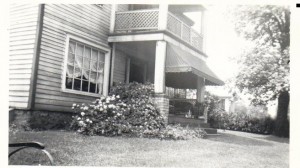
Jackman T Stockdale home in background of Thomas Poe Home ca 1910 (Frances and John Finley Collection)
Continuing the walk down river – two homes west of the Calhoon home was the Jackman Taylor Stockdale residence. At the age of 20 he secured his first work on the river. His experiences grew to be legendary. Up to the time of his death in 1886, he had organized the Pittsburgh and Cincinnati Packet Line, built 28 steamboats in the Pittsburgh area, and was one of the best known operators on the Ohio, Mississippi, and Missouri Rivers. During the Civil War his boats transferred supplies and troops under Gen Grant[9]. During the Montana gold rush, his packet, the str Ida Stockdale, achieved fame as one of only three boats to make five successful trips to Ft Benton, MT. str JT Stockdale lived in Georgetown from 1846 to 1864, then moved to Allegheny City and where his interests turned to the oil refining business. For many of those sixteen years in Georgetown three Missouri River steamboat captains, Calhoon, Poe and Stockdale, lived side by side overlooking the Ohio River.
This home is a good example of the fine homes constructed by river men. It was assembled with wooden pegs and the lumber was transported down the river from Pittsburgh. After the Stockdale left Georgetown, the Peters family with their housekeeper occupied the home. The Peter’s son was a member of the delegation that opened the first US legation in China. He was internationally known for his art collection. And the home in Georgetown contained many items f rom his trips to China.
Five houses up river from Thomas S Calhoon was the George W Ebert home built around 1845. According to the property deed, the land was purchased from Jacob Poe and his wife, Mary Ann Ebert. The home has four large parlors and four bedrooms. The kitchen was attached via the back porch.
During the Civil War, Capt Ebert commanded the steamer Kenton transporting troops along the Mississippi River system between St Louis and Vicksburg. Information about the Kenton service during the Civil War is availble in the National Archives. In 1869 with a load of freight aboard the steamboat Mollie Ebert, Capt George Washington Ebert left Georgetown landing destined for Fort Benton in the Montana Territory. Nancy Ann (Poe) Ebert accompanied her husband on that river voyage. They were steaming right into Indian Territory a few years before General Custer met a bloody defeat at nearby Little Bighorn. The sternwheel packet Mollie Ebert was named after George and Nancy Ebert’s only child Mary Ann (Mollie) Ebert.
The Mollie Ebert did not dock in Ft Benton as suggested in several histories of the Missouri River commerce . Her freight was unloaded at Cow Island which is approximately 130 miles down river. On Jun 16, 1869, the freight was carried around a chute and loaded on two other steamboats for the final leg to Ft Benton. The failure to reach Ft Benton was an intense disappointment. Measured in miles their trip from Georgetown down the Ohio to the Mississippi, up the Mississippi to the Missouri, and up the Missouri to Ft Benton totaled 1,800. The two segments of the journal written by Nancy Poe Ebert cover only 920 miles of the trip over 57 grueling days.
Later that summer, the Mollie Ebert made a trip from Pittsburgh to New Orleans so the year was not a total financial bust. The maiden voyage of the Mollie Ebert was in the winter of 1869 – a trip to New Orleans. On the evening of May 25, 1875, she burned at the Pittsburgh wharf.
After George W Ebert’s death on 24 Apr 1979, Nancy Ann Ebert continued to live in the house with her daughter Mollie Ebert Trimble and her husband John A Trimble and her family.
On Thursday, 5 Jan 1893, Mr and Mrs John A Trimble celebrated their 35th wedding anniversary in the Ebert home. In preparation for the occasion their parlors had been “refurnished and redecorated by a force of artists from Pittsburgh” according to a newpaper clipping. “In the writer’s judgement it would require too much space to enumerate the many costly gifts received, but one feature of the gift giving was worthy of marked attention.” Each guest was presented an engraved silver spoon commemorating the anniversary. An elegant supper was served at 10:00 PM, and at midnight the most important society event of the season in Georgetown ended. My search for a spoon continues.
Just west of the Jacob Poe home was McClure house built around 1830. It was the first brick home in Georgetown. Later it was known as the Peppard house af ter Andrew Jackson McClure died and his widow, Elizabeth Poe, remarried Capt Standish Peppard. Standish Peppard was the first clerk aboard the Buckeye State when she set the time record for a trip from Cincinnati to Pittsburgh in 1850 – 468 miles in 43 hours. Speed records were important. Steamboat captains by nature were high risk gamblers and racing by design was the exciting part of the job. The winning boat and its officers were rewarded with a trophy of gilded antlers which were either mounted in the pilot house or strung on a line between the tall stacks. As long as the boat could retain the horns, it would command higher rates for freight and passengers. The officers, the captain, the pilots, the clerks, engineers, and stewards would also command higher salaries even if they moved to other assignments. Standish Peppard was first clerk on the Buckeye State when it made its famed run.
Capt Peppard also served as first clerk on most of the George W Ebert boats. During the Civil War, he was the first clerk on the steamer Kenton. He made two trips to Ft Benton aboard the Yorktown and was aboard the Mollie Ebert in 1869.
The third house east of the Calhoon residence was the Andrew H Parr home. At one time, there was a tea room in the sun porch on the back. It was quitebusy with visitors in thesummer.
Like the Poe family, the Abraham S Parr children were all rivermen. Brothers Andrew H, John Quincy Adams, and William J were captains and pilots on packets and tow boats. Captains Andrew H and William J served as pilots on troop and supply transports during the Civil War. John QA Parr was first clerk on several Georgetown steamers on trips to Ft Benton.
Capt Andrew H Parr was either the captain or pilot aboard the steamer Melnotte which was noted for its calliope. In Mar 1861 in Wheeling, a local newspaper editor recognized “Dixie’s Land, The Old Gray Horse, Pop Goes the Weasel, and Katy Darling”. The calliope was also mentioned in an article in the Cincinnati in Oct 1859. [10] During the war, the Melnotte was in the Army service from Apr 1, 1863 till Jul 16, 1865. In Jun 1863, the Melnotte was used to transport artillery pieces and 300 men to counter a rebel force (Morgan’s Raiders) purported to have crossed the Ohio River. [11]
The Parr captains and Capt Ebert were half brothers. Mary Ann Hague had five children by her first husband, Frederick Ebert and with Abraham S Parr eight children. The Parr family all were members of the Georgetown Methodist Church. Another curious intra-family relationship was the marriage of George W Ebert to Nancy Ann Poe, sister of Jacob Poe. Conversely, Jacob Poe was married to Mary Ann Ebert, sister of George W Ebert. Captain Standish Peppard’s wife was Elizabeth Poe, the sister of Jacob and Nancy Ann Poe.
Other homes in Georgetown have their stories to tell. The TD Todd house was once a milliner’s shop staffed by Anna B Ditmore. Kinseys also lived there. Mary Kinsey married TD Todd who converted the space into a photography studio. One of the Kinsey sons was an aviator and the propeller of his plane was displayed on one wall of the home.
Another branch of the Kinseys owned a home on Market St. Capt Ben Kinsey lived there with his three maiden sisters. The Kinsey sisters as they were know always entertained the Episcopal Bishop when he visited Georgetown. Although Capt Ben owned a car, he and his sisters could not drive. It was said that Miss Nell had tried, in vain. Young men in town would drive them where they wanted to go.
Georgetown was also well known as a good place for trade in food and other supplies. And it had quite a reputation for its taverns. Some of the early barkeepers in Georgetown were Thomas Foster, Nicholas Krehl, Philip Ducomb, William Carnegie, James Preston and Joseph Smith. John Bever, operated a well known establishment and a store. James Cameron was the barkeep at the Red Lyon, favored by rivermen. Nathanial Potts, an old river pilot, had a tavern on the bluff above the landing where the Thomas S Calhoon home was later built .
In addition to the residential homes, Georgetown supports two churches. The founding of the United Methodist Church is credited to Elizabeth Hephner Poe who was the mother of Nancy Ann (Poe) Ebert. The current church has a direct connection to the steamboat building. It was dedicated on Nov 11, 1877. Rev CW Smith performed the dedication services and at the time it was not known that his father had formed the first class in Georgetown in 1834.[12]
The carpenter work was attributed to George Nash, a carpenter and shipbuilder. Its interior has a wooden ceiling built like the inverted keel of a boat. Its original steeple from the ground to the top of the spire was 98 feet making it visible from the river and useful to pilots for guidance. In 1951, lightning struck the steeple and it was rebuilt to its current height.
The St Luke’s Episcopal Church, built in 1833, is oldest active church in the Diocese of Pittsburgh. It is the oldest church of this faith in Beaver County and one of the oldest west of the Allegheny Mountains. First organized in about 1800, it was admitted into the Diocese of PA in 1814. Francis Reno was its first pastor. The church’s rectangular windows were replaced with stained glass in 1905.
Education of their children was important.
The new Georgetown School built in 1902 had two rooms with two teachers and students from Grades 1-8.
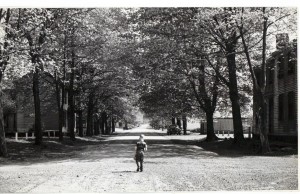
Francis Nash on Deserted Market St (Beaver Valley Times 4 Jun 1955) (Anna L and John F Nash Collection)
When the ferry ceased operation in 1950 after 150 years of service, Georgetown saw the end of yet another era. Georgetown became severely isolated. The river, the natural highway to the west, brought life to the town. Today the only remaining access to Georgetown is the winding road from Hookstown. Local pranksters, sensing the future, modified a road ends sign some years ago to read “World Ends, Four Miles”. “It used to be a river town.” said Lillian Poe Wagner sadly in a newspaper interview as she looked along the deserted streets of the once busy village. “Almost everyone was connected with the river in some way.” [13]
The Georgetown names: Dawson, Laughlin, Poe, Ebert, Calhoon, Stockdale, Peppard, Parr, Kinsey, and others, will forever be entwined with the river and each other. These men: owners, captains, pilots, clerks, engineers, mates, carpenters, stewards, and deckhands, ran boats, built boats, and made Ohio River history. Their lives, greatly lived, are a little known part of a wonderful period of American development.
References.
[1] Charles Dana Gibson and E Kay Gibson, Dictionary of Transports and Combatant Vessels Steam and Sail Employed by the Union Army 1861 – 1868, (Ensign Press, Cambridge, MA 1995), p 152.
[2] Capt Frederick Way, Jr., History in Houses, (S&D Reflector (Dec 1969)).
[3] Capt Frederick Way, Jr., The Steamboating Poe Family, (S&D Reflector) (Dec 1965)).
[4] Arthur B Fox, Pittsburgh during the Civil War, 1860-1865, p. 31-32.
[5] Internet Complete History of the 46th Illinois Veteran
[6] New York Times Aug 15, 1864.
[7] Frederick Way, Jr.,Way’s Packet Directory, 1848-1994, (Ohio University Press, Athens 1994), p. 99.
[8] Capt Frederick Way, Jr., The Steamboating Poe Family, (S&D Reflector (Dec 1965)).
[9] John Newton, A Century and a Half of Pittsburg and Her People, (Lewis Pub Co 1908), pg 312.
[10] Frederick Way, Jr.,Way’s Packet Directory, 1848-1994, (Ohio University Press, Athens 1994), p. 318.
[11] [11] Charles Dana Gibson and E Kay Gibson, Dictionary of Transports and Combatant Vessels Steam and Sail Employed by the Uniion Army 1861 – 1868, (Ensign Press, Cambridge, MA 1995), p 223.
[12] J Dillon and Son, M. E. Church in Georgetown, (The Georgetown Chronicle, (Nov 1877)), pp 4.
[13] George Swetman, Life and Death of a River Town, The Pittsburgh Press, Sunday, Apr 27,1969.
Copyright © 2009 Francis W Nash
All Rights Reserved
